A guide to King Charles' Scottish crown jewels ceremony
- Published
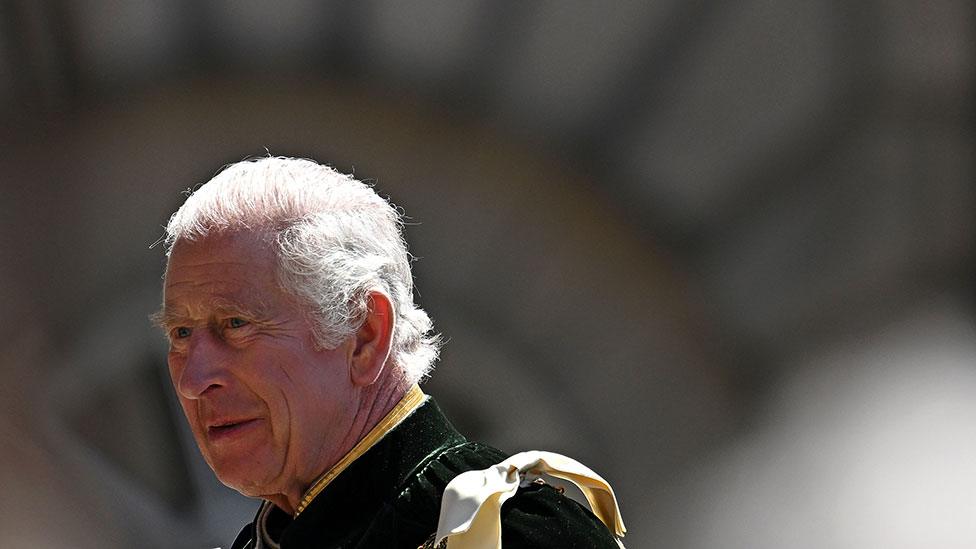
King Charles III was presented with the Scottish crown jewels in a ceremony in Edinburgh marking his Coronation.
It was the historic highlight of the day in which Scotland takes the opportunity to celebrate with the new King.
How did the day unfold?
It began at about 13:15 when a "people's procession" left Edinburgh Castle for St Giles' Cathedral.
About 100 people from all aspects of Scottish life took part in the cavalcade along the Royal Mile, arriving at the historic kirk at about 13:30.
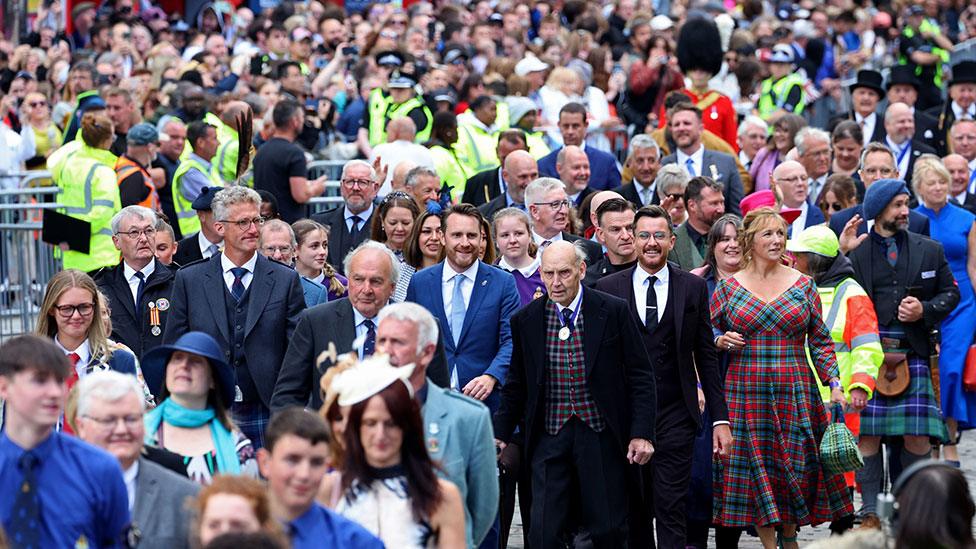
Dozens of invited guests walked from Edinburgh Castle to St Giles Cathedral, ahead of the service
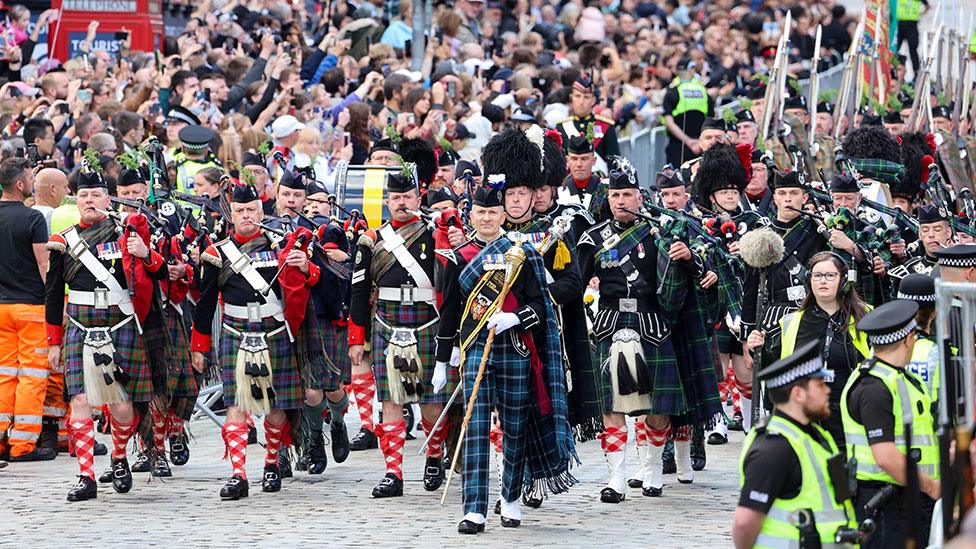
The Combined Cadet Force Pipes and Drums and the Cadet Military Band proceeded down the Royal Mile
They were escorted by The Royal Regiment of Scotland, their mascot Shetland pony Corporal Cruachan IV, and a cadet military band.
At 13:40 a priceless crown, sword and sceptre, known as the Honours of Scotland, travelled in a Rolls Royce from Edinburgh Castle to the kirk.
They were escorted by The King's Body Guard for Scotland (the Royal Company of Archers) and a guard of honour formed by contingents of the Navy, Army and Royal Air Force.
At the same time members of the Household Cavalry Mounted Regiment processed along the Royal Mile from the Palace of Holyroodhouse to St Giles'.
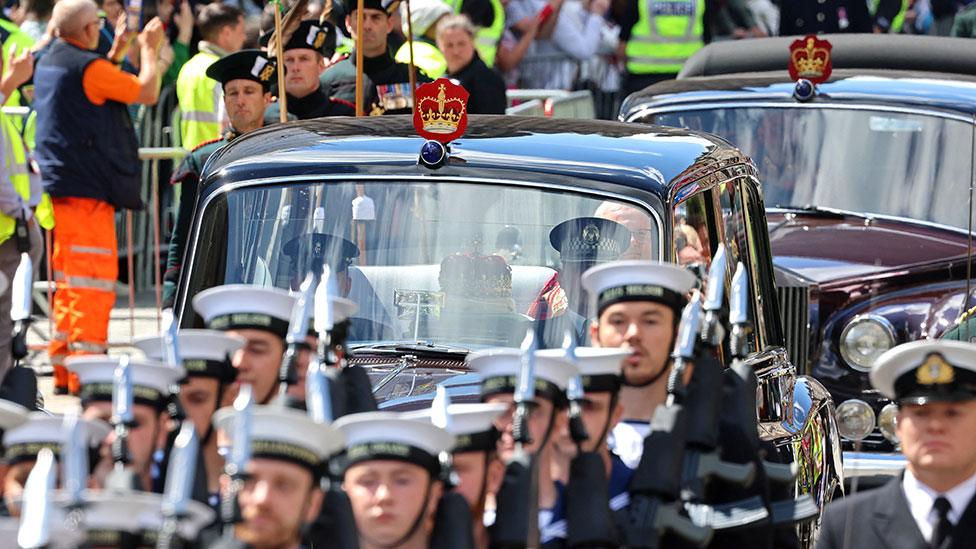
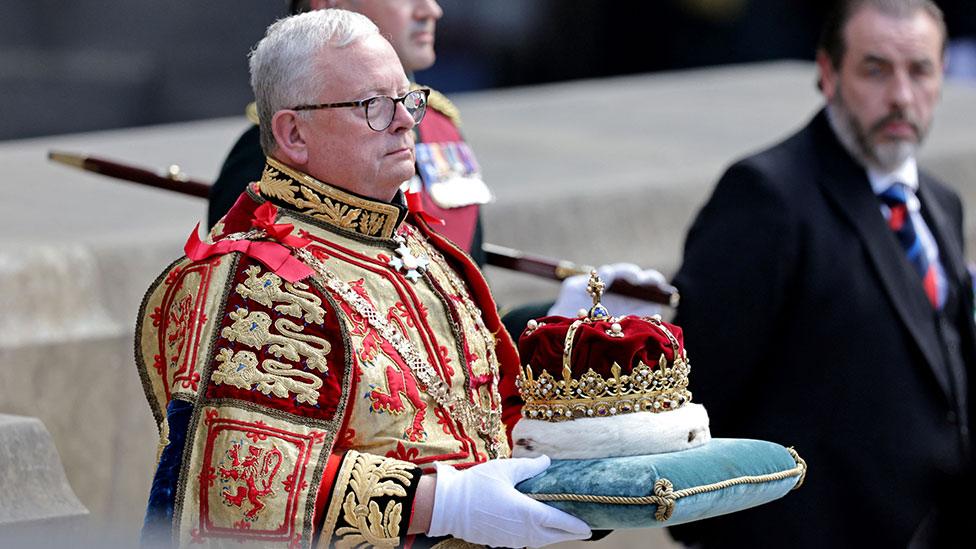
The crown was carried into the national service of thanksgiving after being transported to St Giles in a Rolls Royce

The musical accompaniment was provided by the Royal Marine Band (Scotland) and the Pipes, Drums and Bugles of the 2nd Battalion, the Royal Regiment of Scotland.
The separate royal procession along the Royal Mile saw the King and Queen Camilla leave Holyroodhouse - their official Scottish residence - at 14:05.
They were joined by the Prince and Princess of Wales, who are known as the Duke and Duchess of Rothesay in Scotland.
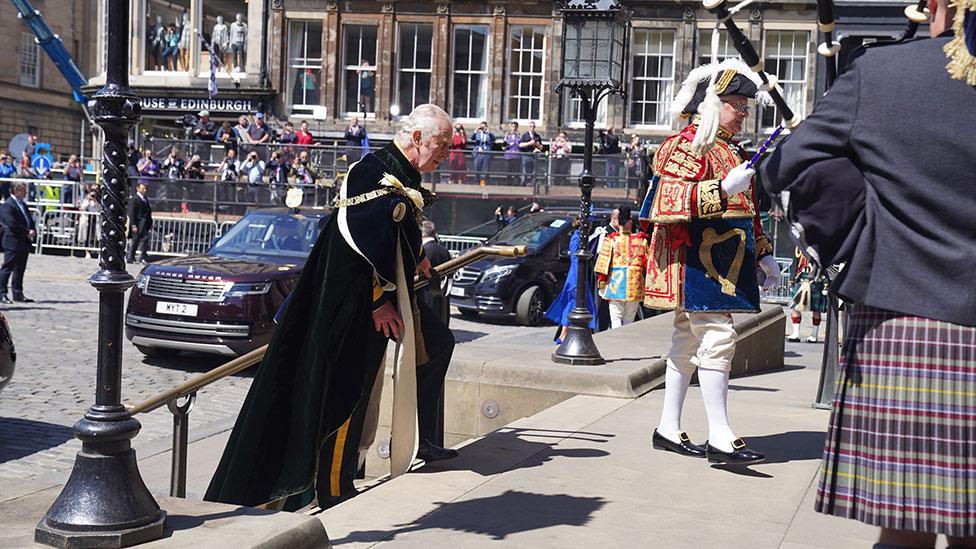
King Charles arrived at St Giles following the short journey from the Palace of Holyroodhouse
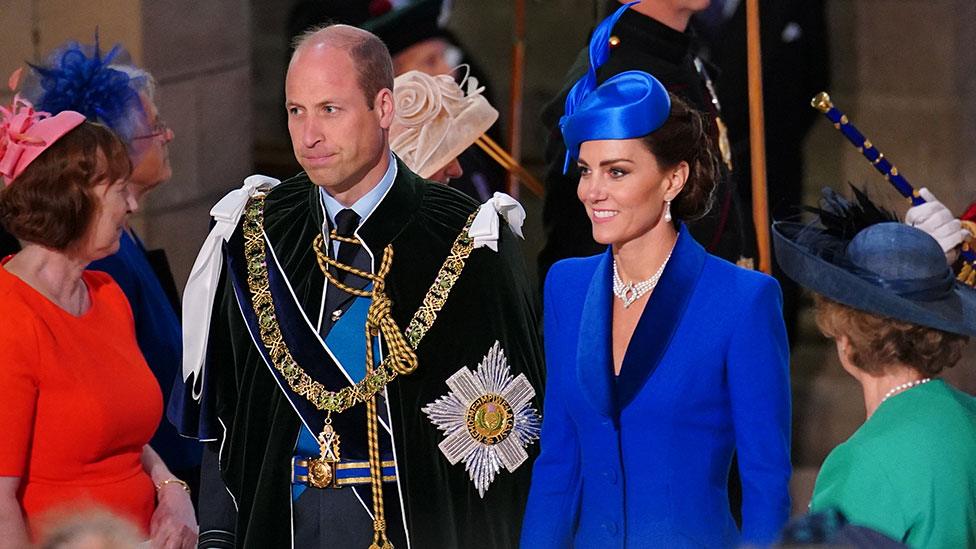
The Duke and Duchess of Rothesay joined the service of thanksgiving
During a national service of thanksgiving, which began at 14:15, the King received the Honours of Scotland.
The hour-long service mixed Scottish royal tradition with new music written especially for the occasion.
Nicola Benedetti and The Honours of Scotland Ensemble performed Peter Maxwell Davies' Farewell to Stromness.
And Joy Dunlop, a BBC Weather presenter and Gaelic singer, sang Gaelic psalm And I Shall Dwell in God's House, which was composed by Paul Mealor for the service.
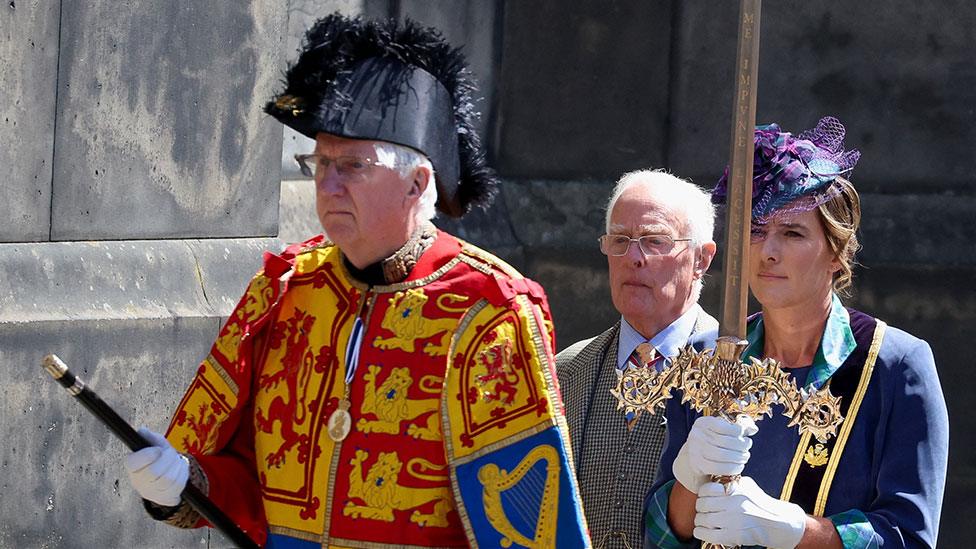
Dame Katherine Grainger carried the new Elizabeth sword into the service
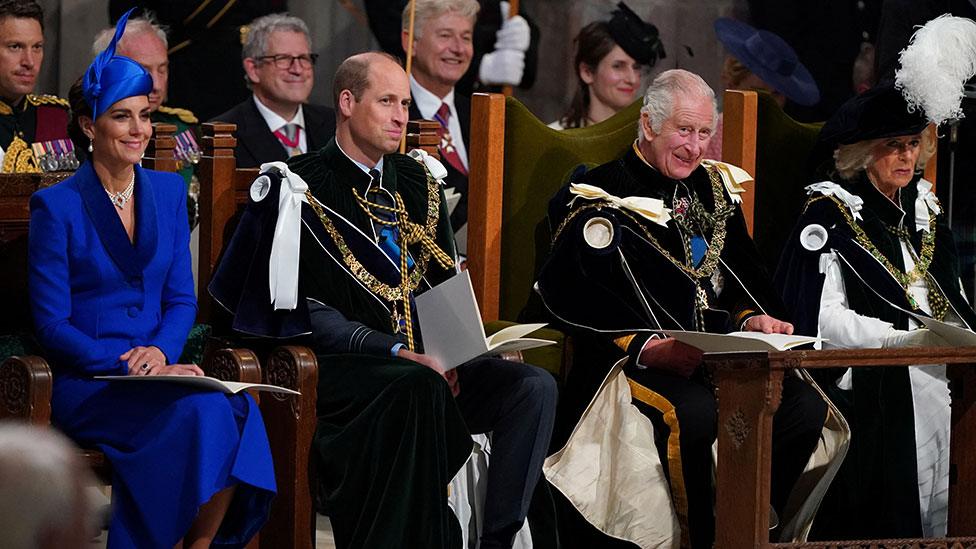
The moderator of the General Assembly of the Church of Scotland, Rt Rev Sally Foster-Fulton preached the sermon.
The crown, sceptre and sword - the Honours of Scotland - were presented to the King by dignitaries including former Olympic rower Dame Katherine Grainger.

The King was presented with the crown by the Duke of Hamilton and Brandon
The Stone of Destiny - which played a significant part in the King's Coronation at Westminster Abbey - was also in St Giles' for the service.
A 21 gun salute fired from Edinburgh Castle as the royal procession travelled back to Holyroodhouse.
Official events ended with a fly-past by the Red Arrows at 15:40.
Who took part in the parade?
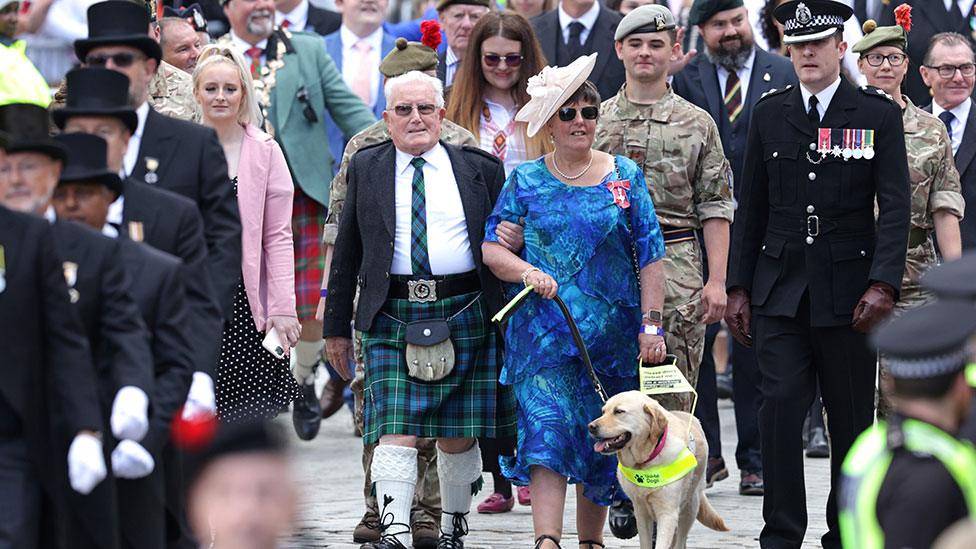
People from all walks of life took part in the people's procession along the Royal Mile
Charities, groups and organisations were represented in the people's procession along one of Edinburgh's most famous streets.
They included school crossing patrols from Edinburgh, NHS workers, Royal Mail staff, refugees, emergency service workers and representatives of the Scottish Parliament.
You can find the full list of the organisations to be represented here., external
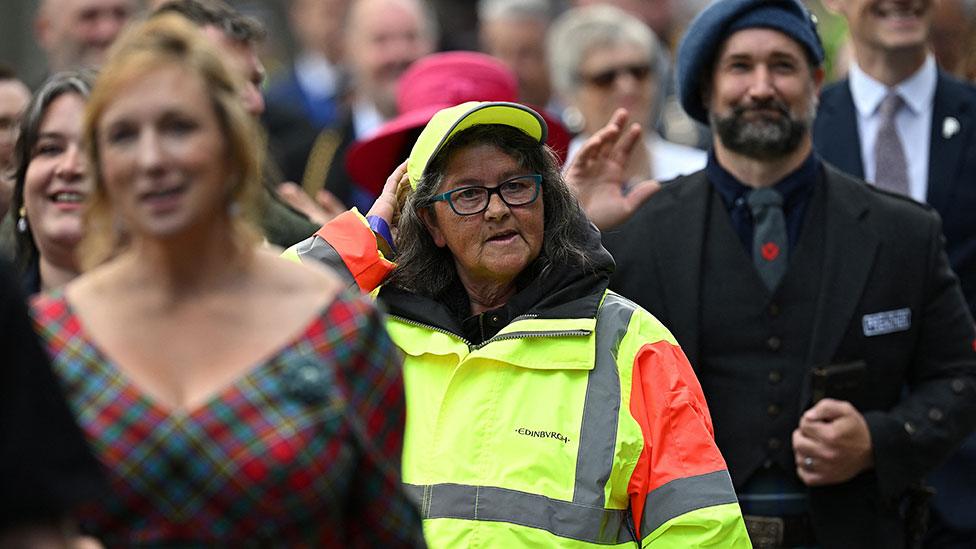
Members of the public were able to watch the procession on the Royal Mile. They were advised to arrive early and prepare for "changeable weather conditions".
During the service of thanksgiving at St Giles', three pipers from the King's former school, Gordonstoun, played for him.
The congregation included those who took part in the people's procession as well as politicians and faith leaders.
What are the Honours of Scotland?
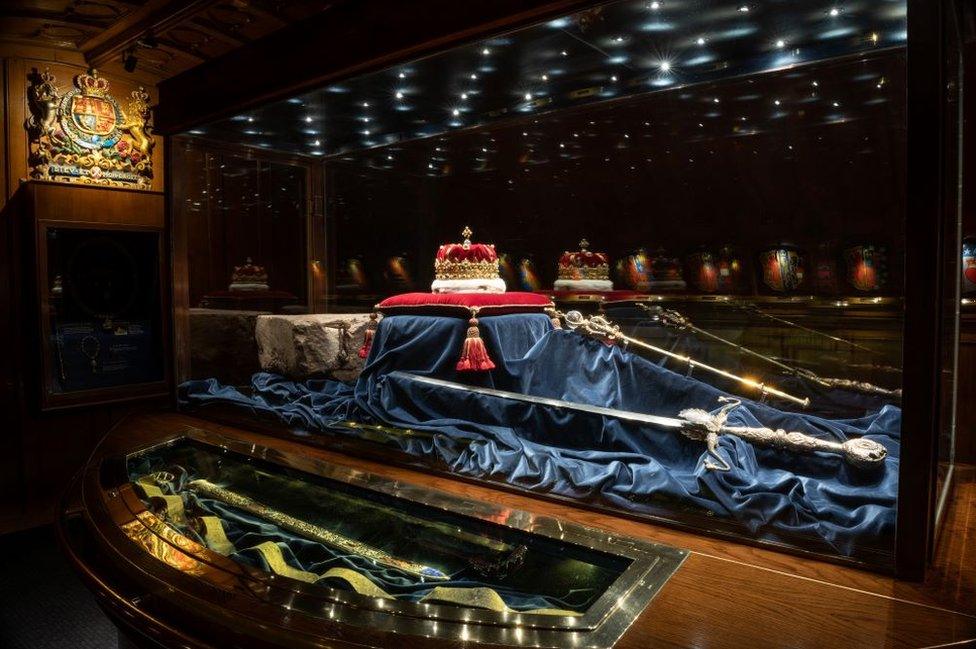
The Honours of Scotland are usually on display at Edinburgh Castle
Made of gold, silver and precious gems, they are the oldest crown jewels in Britain and comprise the priceless crown, sceptre and sword of state.
They are items of immense significance and many will remember the Crown of Scotland sitting atop the Queen's coffin when she lay in state at St Giles' Cathedral.
The crown was made for James V, who first wore it at the Coronation of Queen Mary of Guise in 1540.
Mary Queen of Scots was the first to be crowned using the new crown and sceptre together, in 1543. The origins of the sceptre are less certain - it may have been a papal gift to James IV.
However the sword King Charles was presented with is brand new, and commissioned because the existing 16th Century sword is too fragile to handle.
Named after his late mother, it is called the Elizabeth sword.
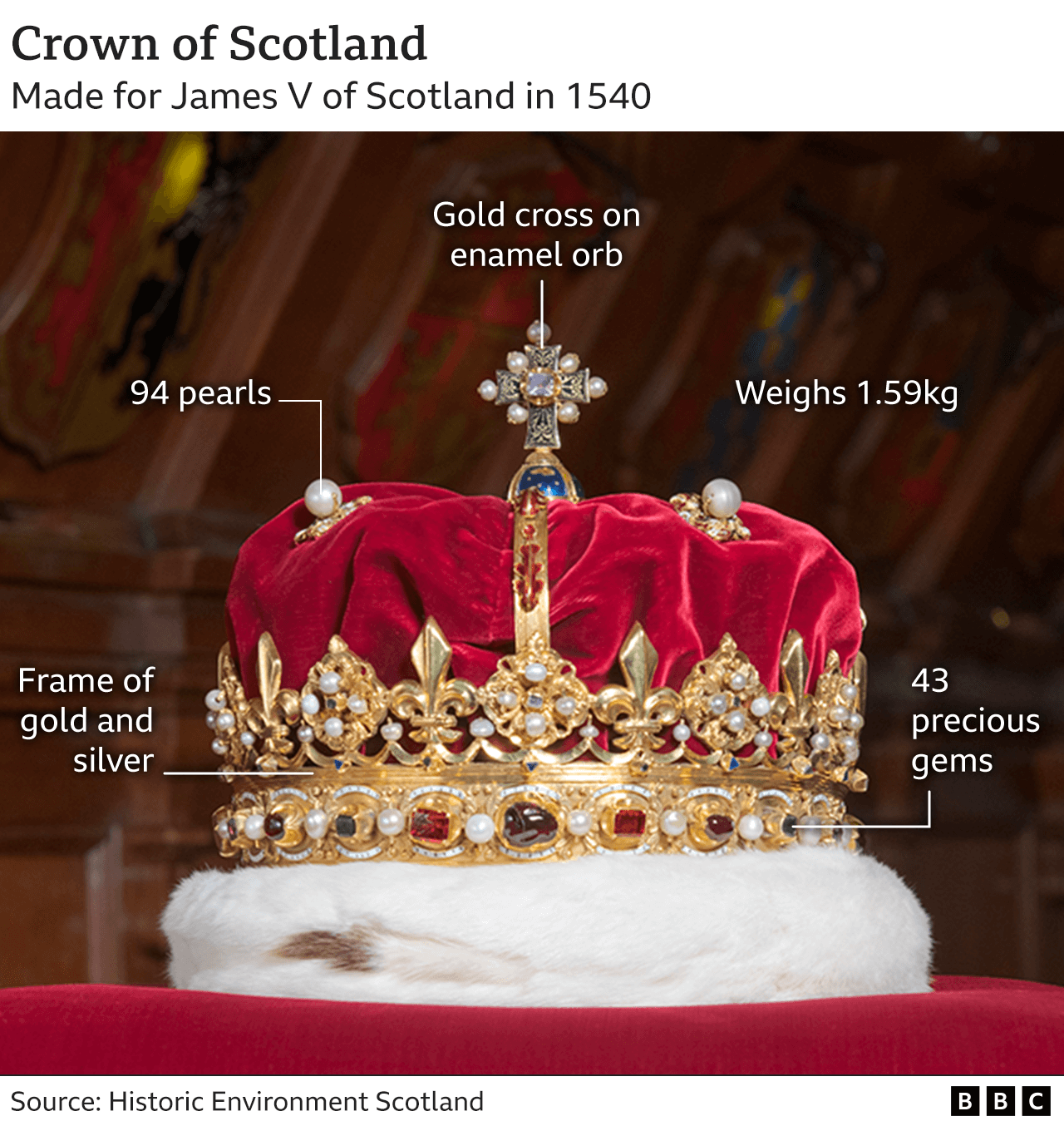
The Honours have had a turbulent past. They were removed from the castle and hidden in 1651-60 to keep them from Oliver Cromwell's army.
In 1707, following the Act of Union between England and Scotland, they were locked in a chest and sealed away.
In 1818, Sir Walter Scott, the famous novelist, rediscovered the Honours - along with a mysterious silver wand.
The Honours of Scotland and their accompanying exhibition are located on the first floor of the Royal Palace on the east side of Crown Square at Edinburgh Castle.
What happened in 1953?

Queen Elizabeth II on her first official tour of Scotland after she was crowned in 1953
Queen Elizabeth II and Prince Philip travelled north by train, arriving to a great fanfare at Edinburgh's Waverley Station.
The royal couple rode through the capital, greeting crowds on both sides of Princes Street and up the Royal Mile in an open-top carriage procession, escorted by the Royal Company of Archers.
They attended the thanksgiving service at St Giles' which was led by the Moderator of the General Assembly of the Church of Scotland, James Pitt-Watson.
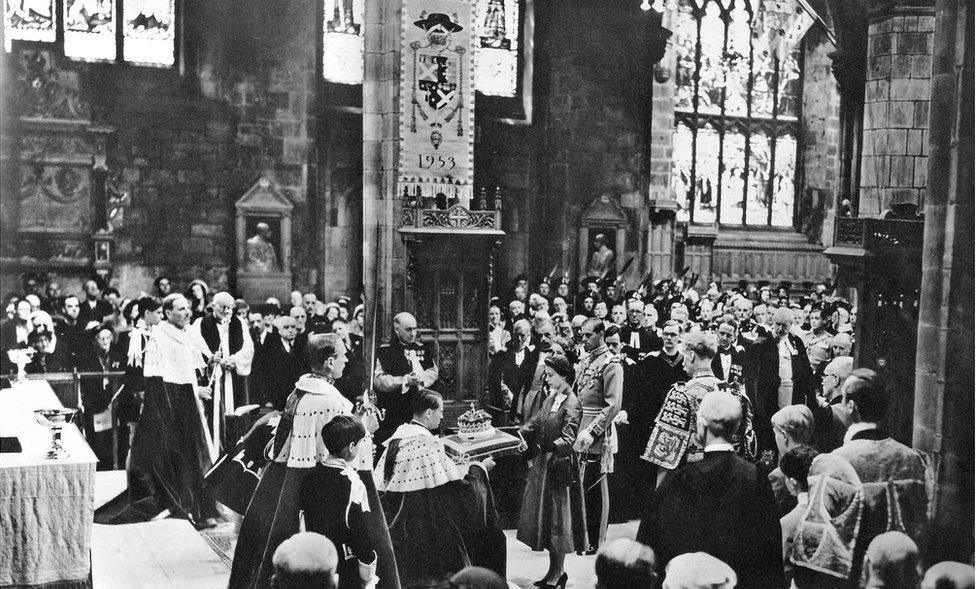
Queen Elizabeth is presented with the Crown of Scotland inside St Giles Cathedral in 1953
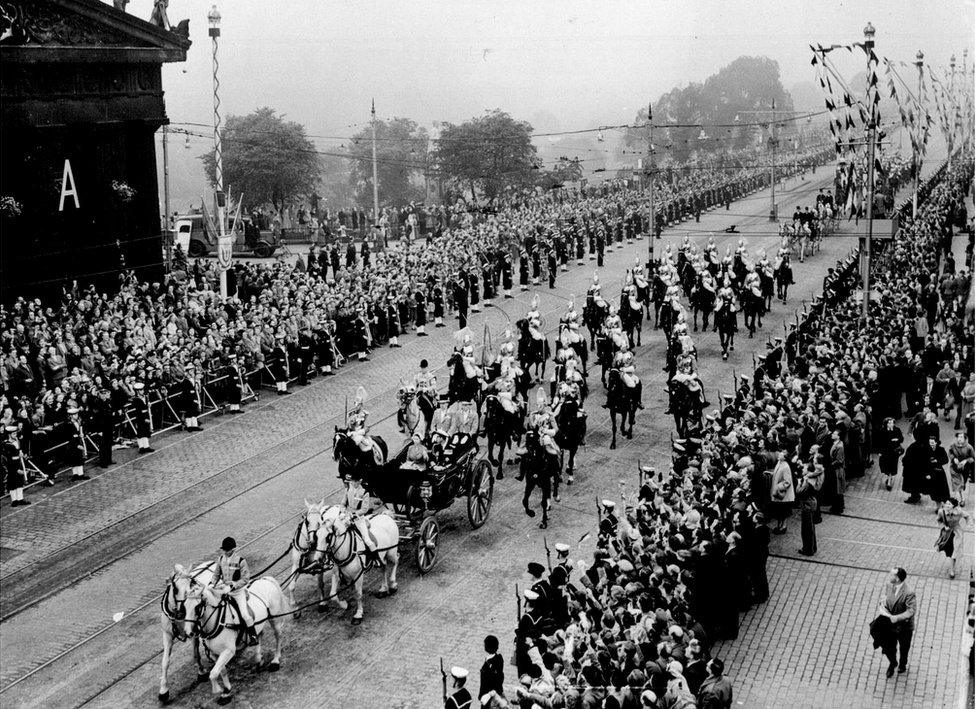
The new Queen and Prince Philip rode through the streets of Edinburgh, along Princes Street and up the Royal Mile, escorted by the Royal Company of Archers.
A congregation of 1,700 watched as the Queen received the Honours from the Dean of the Thistle, Charles Warr, and then passed the Crown of Scotland to the Duke of Hamilton, the Sword of State to the Earl of Home, and the Sceptre to the Earl of Crawford and Balcarres.
The last time the ceremony had been enacted before this was in 1822 during the visit of King George IV.
The Queen dressed in "day clothes" for the ceremony, not ceremonial robes, a deliberate decision made by palace officials to avoid the service being interpreted as a coronation.
Reportedly, this was not received well by the media who saw it as a slight.
Philip, the Duke of Edinburgh, wore a field marshall's uniform.
All images subject to copyright
- Published3 July 2023
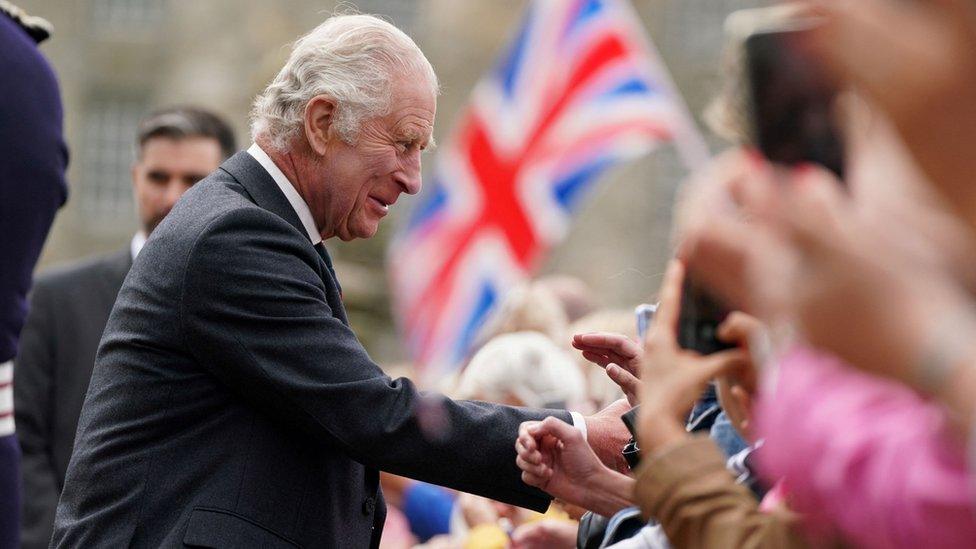
- Published30 June 2023
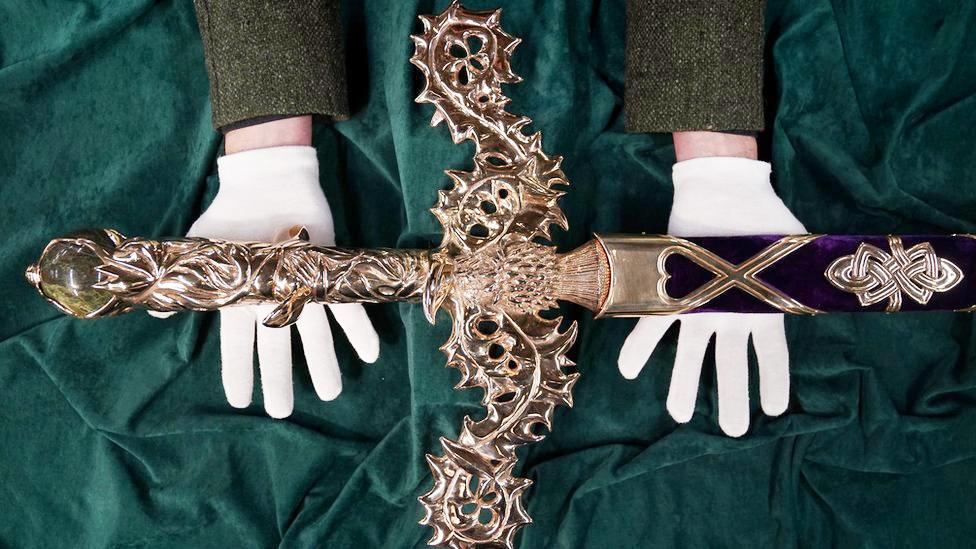
- Published1 May 2023
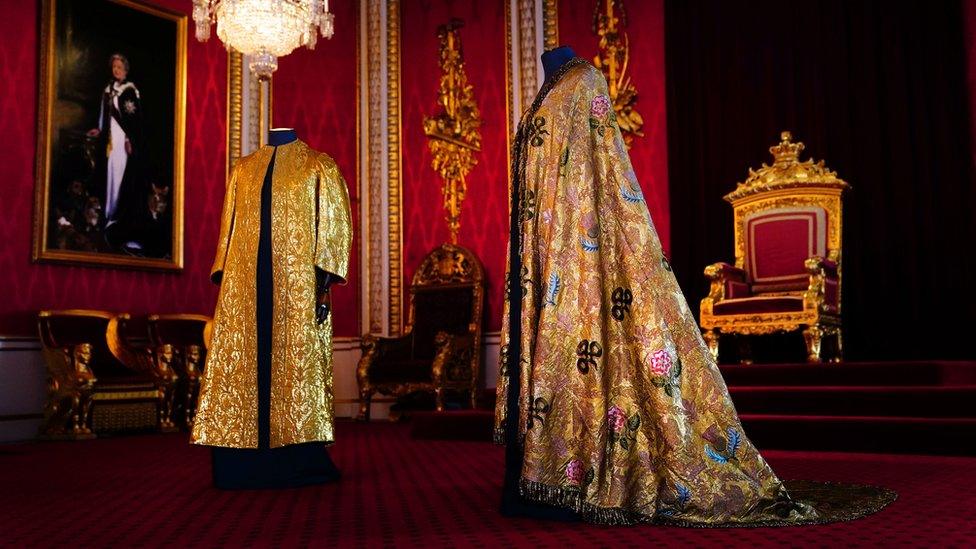
- Published28 April 2023
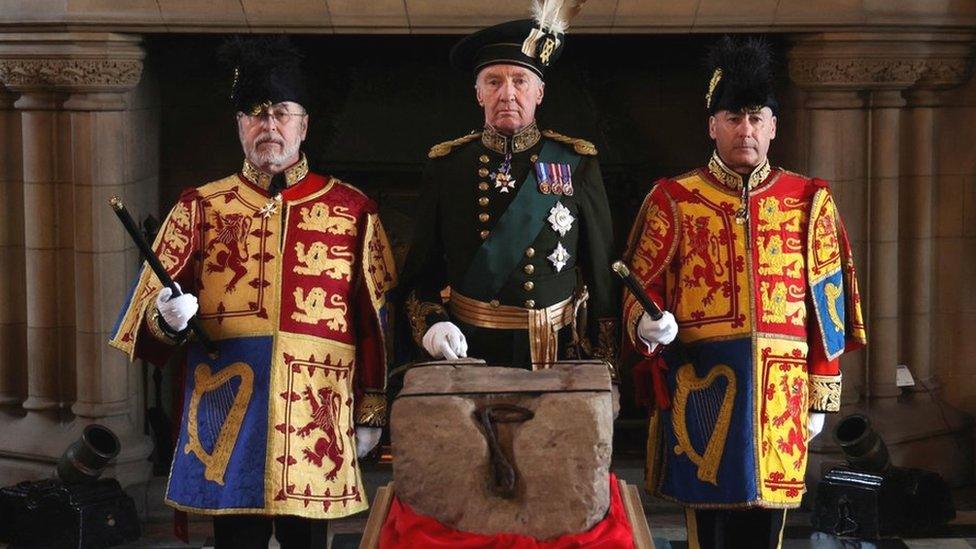
- Published24 March 2023
